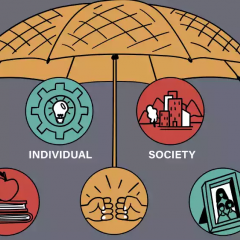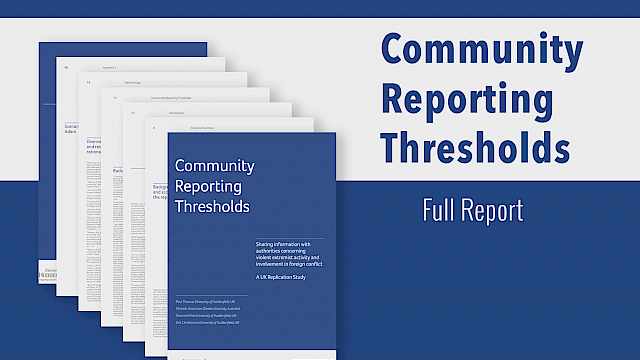Executive summary
This report sets out the findings of research to understand the potential of the Good Lives Model (GLM) to interpret trajectories into and out of violent extremism and considers the implications for policy and practice.
The Good Lives Model (GLM) is a well-developed manifestation of a strength-based approach to rehabilitation. The model argues that focusing on developing strengths and enhancing protections, rather than solely managing and controlling risk factors, offers a more fruitful route to preventing (re)offending. The GLM has become an increasingly prominent part of efforts to rehabilitate criminal offenders, however its potential with respect to the violent extremist population has not been fully exploited.
This report is informed by a review of research on protective factors set out in an earlier report: Conceptualising Protective Factors: Strength-Based Approaches (Marsden and Lee, 2022) that established the theoretical foundation for the empirical research set out here.
Findings
The analysis suggests that the model offers a coherent framework for analysing the trajectories of former right-wing extremists across the stages of pre-engagement, engagement, involvement, disengagement and reintegration. Based on analysis of 18 biographies and autobiographies of former far-right extremists, the research found that:
- Involvement in violent extremist groups can be interpreted as an effort to attain primary goods.
- Goods differ in importance and relate to each other in particular ways.
- The nature and function of goods can change over the course of someone’s trajectory.
- Barriers to achieving goods seem to play a role in motivating people to seek alternative routes to achieving them through involvement in extremist groups.
- Obstacles, particularly internal and external barriers to achieving goods, can help interpret pathways into and out of extremism.
- Factors such as ideology, identity and socio-political context influence the attainment of goods and need to be further developed within the model.
Implications
The findings have implications for interventions which try to prevent and counter violent extremism (P/CVE). Intervention design and case management processes would benefit from balancing out the dominance of risk-oriented approaches by:
Understanding goods
- Developing a detailed understanding of an individual’s motivations and needs and the nature and function of goods relevant to them.
- Consider prioritising aspects of intervention which support goods relating to healthy living, relatedness and agency as these seem to represent core goods.
Maximising opportunities to access goods
- Focusing on developing skills and strengths to enable individuals to attain goods in pro-social, normative ways.
- Supporting the attainment of goods through direct or indirect routes.
- Reducing internal and external capacity barriers that hinder the attainment of goods.
Developing self-understanding
- Work with individuals to better understand their past and integrate group involvement in their life narrative.
- Provide opportunities for individuals to encounter the potential for redemption and explore what kind of redemption script might be available to them.
Considering implications for prevention
- Develop a GLM assessment framework that in practice, and ideally with the engagement of the individual concerned, helps identify core goods and barriers to achieving them pro-socially.
- Evolve the GLM framework so it is able to support diversionary approaches in the context of efforts to prevent violent extremism.
Next steps
The findings and limitations of this study suggest that future research should:
- Employ in-depth and larger-scale research to explore CVE practitioners’ views of the GLM and strengths-based approaches.
- Assess whether the GLM can be applied in PVE interventions.
- Identify the implications of the GLM for risk assessment processes.
- Evaluate programmes that incorporate strengths-based approaches, including the GLM, to understand their influence on intervention outcomes.
- Analyse existing interventions to learn how the sequencing of strengths- and risk-oriented components can shape levels of engagement and motivation, and intervention outcomes.
- Apply Qualitative Secondary Analysis to systematically look for patterns of goods and barriers across larger and more varied samples.
- Further investigate how factors such as ideology, identity and socio-political context influence the attainment of goods and how these factors interact with the GLM.
- Analyse the role of gender in relation to the GLM in greater depth and consider the implications for interventions.
- Understand the cross-cultural applicability of the GLM to explore whether goods are best understood as universal and/ or learn how they are shaped by socio-cultural factors.
- Assess whether the GLM can be applied to Islamist and left-wing extremist trajectories.
The research for this report was supported by the Center for Research on Extremism, C-REX. C-REX is a cross-disciplinary centre for the study of right-wing extremism, hate crime and political violence at the University of Oslo.
Read more
Cherney, A., & Koehler, D. (2023). What Does Sustained Desistance from Violent Extremism Entail: A Proposed Theory of Change and Policy Implications. Terrorism and Political Violence, 1-16. https://doi.org/10.1080/09546553.2023.2215348
Dean, C. (2014). The Healthy Identity Intervention: The UK’s development of a psychologically informed intervention to address extremist offending. In A. Silke (Ed.) Prisons, Terrorism & Extremism, Critical Issues in Management, Radicalisation and Reform (pp. 89-107). London: Routledge.
Dickson, S. R., Willis, G. M., & Mather, D. (2018). Protective factors and the good lives model: Combining positive approaches to assessment and treatment. In E. L. Jeglic & C. Calcis (Eds.), New Frontiers in Offender Treatment (pp. 43-56). Springer: Cham.
Hewitt, J., Lee, B., & Marsden, S. (2022). Protective Factors In Risk Assessment: Practitioner Perspectives. Centre for Research and Evidence on Security Threat, 1-28. Protective Factors in Risk Assessment: Practitioner Perspectives (crestresearch.ac.uk)
Laws, D. R., & Ward, T. (2011). Desistance and sexual offending: Alternatives to throwing away the keys. New York, NY: Guildford
Marsden, S. V. (2017). Reintegrating Extremists: Deradicalisation and Desistance. London: Palgrave Macmillan.
Marsden, S., & Lee, B. (2022). Conceptualising Protective Factors: Strength-Based Approaches. Centre for Research and Evidence on Security Threat, 1-30. Conceptualising Protective Factors: Strengths-Based Approaches (crestresearch.ac.uk)
Marsden, S., & Lee, B. (2022). Protective Factors For Violent Extremism And Terrorism: Rapid Evidence Assessment. Centre for Research and Evidence on Security Threat, 1-38. Protective Factors For Violent Extremism And Terrorism: Rapid Evidence Assessment (crestresearch.ac.uk)
Maruna, S. (2016). Desistance and restorative justice: It’s now or never. Restorative Justice, 4(3), 289-301.
Maruna, S., & LeBel, T. P. (2003). Welcome home? examining the “Re-entry Court” concept from a strengths-based perspective. Western Criminology Review, 4(2), 91-107. https://doi.org/10.1080/20504721.2016.1243853
Maslow, A. H. (1958). A Dynamic Theory of Human Motivation. In C. L. Stacey & M. DeMartino (Eds.), Understanding human motivation (pp. 26–47). Howard Allen Publishers. https://doi.org/10.1037/11305-004
Ryan, R. M., & Deci, E. L. (2000). Self-determination theory and the facilitation of intrinsic motivation, social development, and well-being. American Psychologist, 55 (1), 68–78. 10.1037/0003-066X.55.1.68
Ward, T., & Fortune, C. A. (2013). The good lives model: Aligning risk reduction with promoting offenders’ personal goals. European Journal of Probation, 5(2), 29–46.
Ward, T., Vess, J., Collie, R. M., & Gannon, T. A. (2006). Risk management or goods promotion: The relationship between approach and avoidance goals in treatment for sex offenders. Aggression and Violent Behavior, 11(4), 378-393. https://doi.org/10.1016/j.avb.2006.01.001
Copyright Information
As part of CREST’s commitment to open access research, this text is available under a Creative Commons BY-NC-SA 4.0 licence. Please refer to our Copyright page for full details.
IMAGE CREDITS: Copyright ©2024 R. Stevens / CREST (CC BY-SA 4.0)






